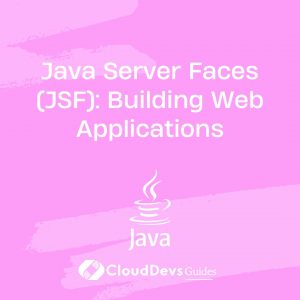Java Server Faces (JSF): Building Web Applications
In the realm of web development, Java Server Faces (JSF) stands as a robust framework for crafting dynamic and interactive web applications. With its component-based architecture and seamless integration with Java EE, JSF offers developers a powerful toolset to streamline the development process and deliver feature-rich web solutions. Let’s delve into the world of JSF, exploring its key features, advantages, and notable examples of its application in real-world scenarios.
Understanding Java Server Faces (JSF)
At its core, JSF simplifies the creation of user interfaces for Java web applications by providing a set of reusable UI components that can be easily integrated into web pages. Leveraging the Model-View-Controller (MVC) design pattern, JSF separates the presentation layer (View) from the application logic (Model and Controller), promoting code modularity and maintainability.
Key Features of JSF
- Component-Based Architecture: JSF adopts a component-based approach where UI elements are encapsulated as reusable components, allowing developers to focus on building functionality rather than dealing with low-level HTML markup.
- Event-Driven Programming Model: With built-in support for event handling, JSF enables developers to respond to user actions such as button clicks or form submissions, facilitating the development of interactive web applications.
- Integration with Java EE: JSF seamlessly integrates with other Java EE technologies such as Servlets, JSP, and EJB, enabling developers to leverage the full power of the Java platform for enterprise-grade web development.
- Rich Set of Built-in Components: JSF provides a rich library of standard UI components including input fields, buttons, tables, and navigation elements, empowering developers to create visually appealing and user-friendly interfaces.
Advantages of Using JSF
- Rapid Development: By abstracting away the complexities of web development, JSF accelerates the development cycle, allowing developers to focus on business logic and application functionality.
- Cross-Browser Compatibility: JSF generates HTML markup that is compatible with various web browsers, ensuring a consistent user experience across different platforms and devices.
- Built-in Ajax Support: JSF comes with built-in support for Asynchronous JavaScript and XML (Ajax), enabling developers to create dynamic and responsive web applications without the need for additional JavaScript libraries.
Examples of JSF in Action
- Enterprise Resource Planning (ERP) Systems: Many enterprise-level ERP systems leverage JSF for building sophisticated user interfaces that seamlessly integrate with backend systems for managing business processes such as inventory management, human resources, and accounting.
- ERPNext: An open-source ERP platform built using JSF, offering modules for accounting, CRM, project management, and more.
- Customer Relationship Management (CRM) Applications: CRM applications rely on JSF to deliver a rich and intuitive user experience for managing customer interactions, tracking sales leads, and analyzing customer data.
- SugarCRM: A popular CRM solution that utilizes JSF for its web interface, providing features for sales automation, marketing campaigns, and customer support.
- E-Commerce Platforms: E-commerce platforms harness the power of JSF to create engaging online storefronts with advanced features such as product catalogs, shopping carts, and secure payment processing.
- Magento: A leading e-commerce platform built using JSF, offering customizable storefronts, order management, and marketing tools for online retailers.
Conclusion
Java Server Faces (JSF) emerges as a compelling choice for building web applications, thanks to its component-based architecture, seamless integration with Java EE, and robust set of features. By harnessing the power of JSF, developers can streamline the development process, deliver engaging user experiences, and stay ahead in today’s competitive web landscape.
In summary, JSF empowers developers to unleash their creativity and build web applications that not only meet but exceed user expectations, driving business growth and success in the digital age.
Table of Contents









